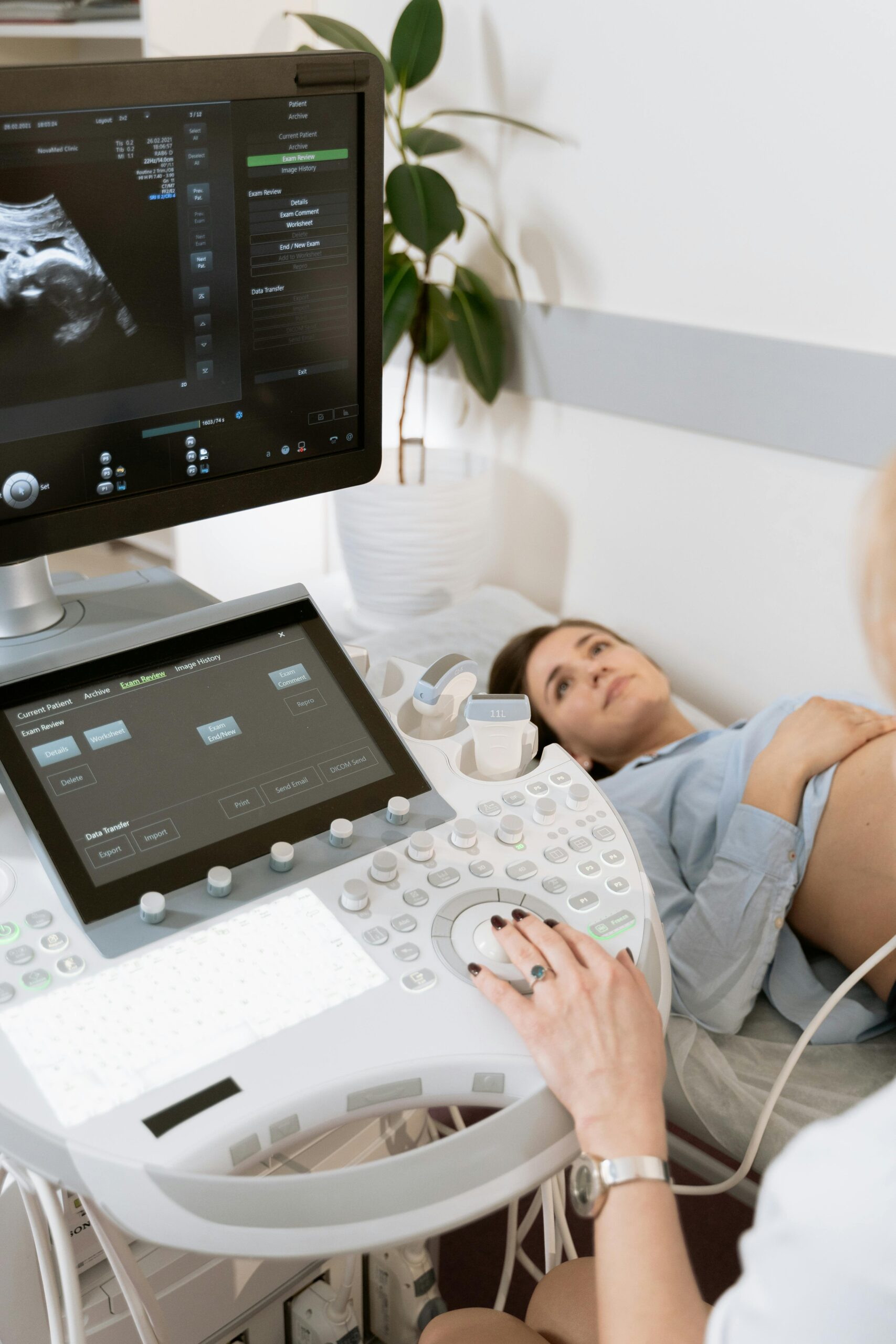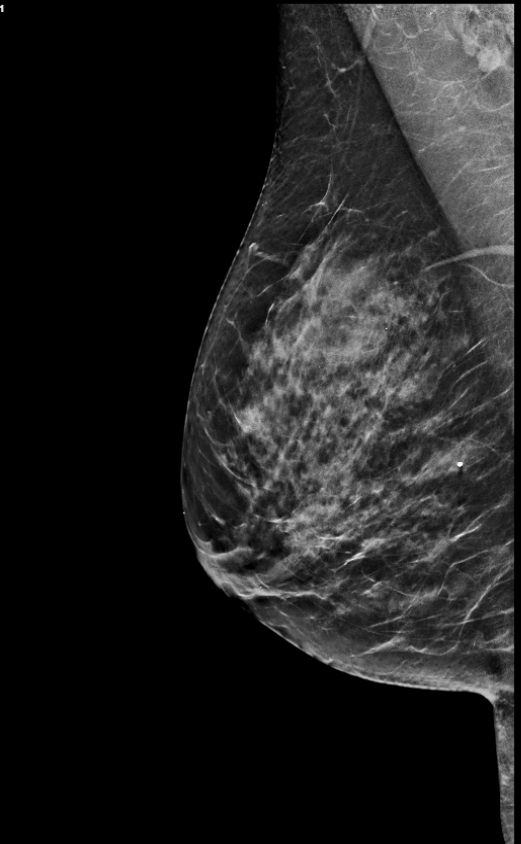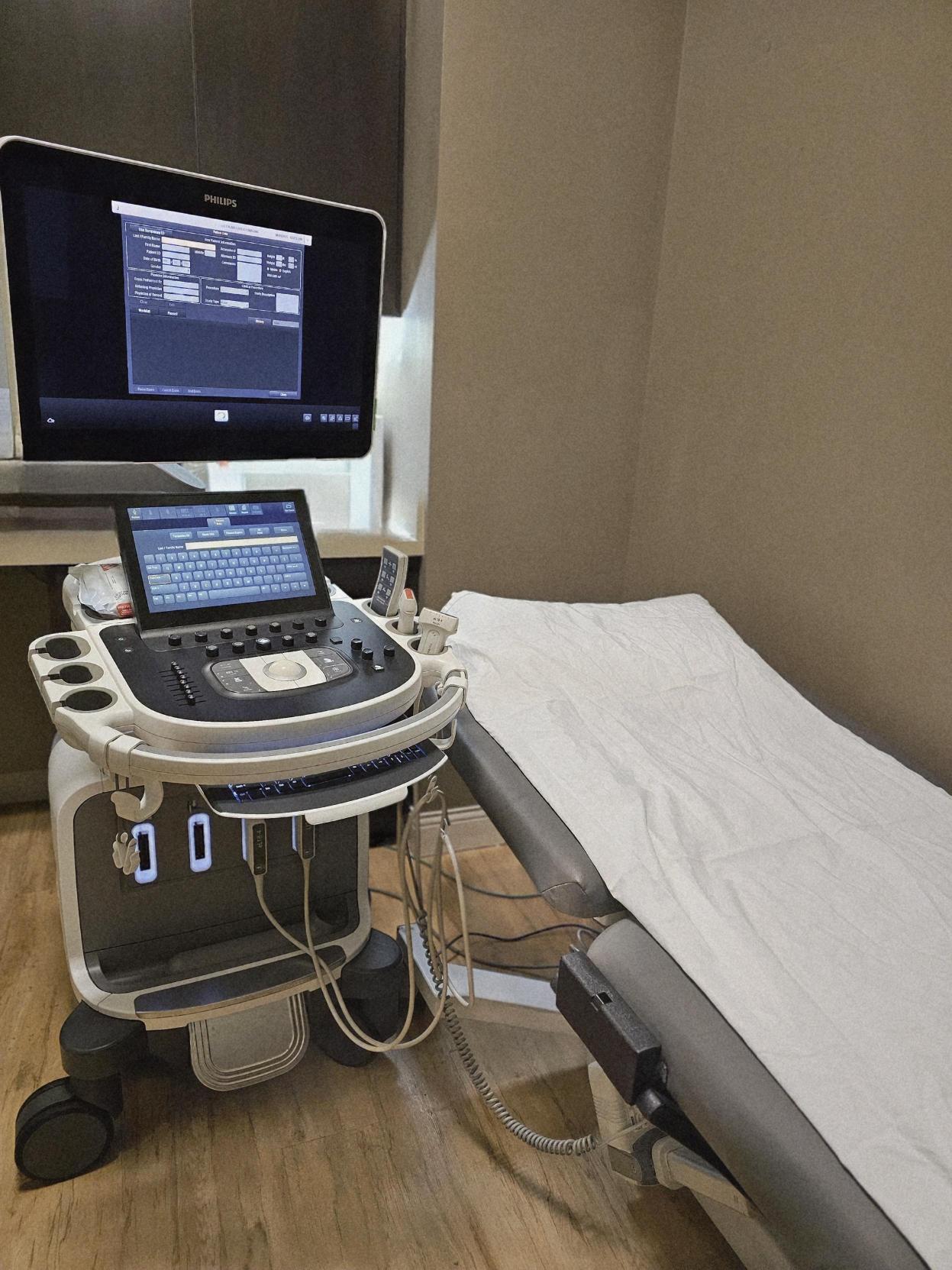12200 Renfert Way, Ste. 100, Austin, TX
*On-Site Dedicated Parking & Free Valet*
Book Your Appointment: 512.652.7001
12200 Renfert Way, Ste. 100, Austin, TX
*On-Site Dedicated Parking & Free Valet*
Book Your Appointment: 512.652.7001
Pregnancy is an exciting time, and skilled obstetric care is essential for ensuring both mother and baby remain healthy. Austin Area Ob-Gyn & Fertility is a trusted provider of obstetrics & gynecological care for women throughout the Austin, Texas, area, providing patient-centered care that focuses on total health and wellness.
Prenatal exams provide very important information about the health of the mother and the baby. During the exams, the mother will be weighed and her blood pressure will be measured and recorded. A blood test and urine test may be performed and the doctor may measure the belly. Depending on how far the pregnancy has progressed, the doctor may listen to the baby’sheartbeat using a monitor that allows the mother to listen as well, and an ultrasound may beordered to assess the baby’s development, confirm a delivery date and potentially determine gender. Mothers will be asked about any symptoms they may be experiencing and will be provided with information and guidance to help them and their babies stay healthy.
High-risk pregnancies are those in which the health of the baby or the mother (or both) are compromised during pregnancy or delivery. Women who have high-risk pregnancies often need additional testing or special care throughout pregnancy to ensure they and their babies stay healthy. Some of the most common causes of high-risk pregnancies include:
Most women will see the obstetrician once a month for the first seven months or so of pregnancy, then every two weeks until the 36th week, at which time visits will be weekly until delivery. Women with high-risk pregnancies usually need to visit more frequently. *Individual Results May Vary

Austin Area Ob-Gyn & Fertility is a top-ranked provider of gynecology care and treatment for women throughout the Austin, Texas, area. The doctors at Austin Area Ob-Gyn & Fertility are skilled in an array of gynecology services aimed at helping women of every age enjoy optimal health and wellness.
Gynecology exams are critical for women of all ages because they include special assessments aimed at evaluating a woman’s special health needs as she gets older and passes through different stages of life. By having routine gynecology exams, a woman’s health can be optimized depending on the specific health issue’s she’s facing. Plus, gynecology exams can help identify subtle signs of diseases in their earliest stages so they can be appropriately and promptly treated, and they also ensure women receive the health screenings and lifestyle guidance they need based on their individual risk factors.
A routine gynecology exam begins with a personal and family medical history to look for potential risk factors for diseases, followed by measurements of weight and blood pressure. Patients are also asked about their lifestyle habits and any symptoms they may be experiencing, as well as any medications or supplements they may be taking. During the exam, the doctor listens to the heart and lungs and palpates (gently presses) the belly to look for areas of tenderness. A clinical breast exam will also be performed, and a pelvic exam with a Pap test or HPV test may also be performed. During the pelvic exam, a lubricated instrument called a speculum is inserted into the vagina and used to gently widen the vaginal canal so the interior of the vagina and the cervix (the opening of the uterus) can be visually evaluated and a Pap test can be performed. The exam is painless and takes just a few minutes.
A Pap test is a medical screening test that uses a long-handled swab to remove some cells from the surface of the cervix. The cells are then examined under a microscope to look for abnormalities that could indicate the presence of cancer or other medical issues like infections. Pap tests are usually performed once every three years for women between the ages of 21 and 64. After age 64, they may be performed less frequently.
*Individual Results May Vary

Fertility problems can be caused by many issues, and getting a proper diagnosis is the key to effective treatment and successful conception. AAOBGYN uses advanced diagnostic and treatment techniques aimed at helping couples overcome fertility problems so they can start or add to their family.
Infertility occurs in men as well as women, and several factors may be causing infertility. In men, fertility problems usually arise as a result of problems with the structure or motility (movement) of the sperm or in the concentration or number of sperm present. Problems with ejaculation or genetic issues can also cause fertility issues in men. In women, the most common causes of infertility include:
Today, there are many tests that can be performed to determine the underlying cause of fertility problems so the most appropriate treatment can be recommended. Blood testing, sperm sampling, pelvic exams, ultrasound and other diagnostic imaging and evaluations all may be used depending on the symptoms of infertility, and other exams may be performed to look inside the uterus to evaluate the uterus, ovaries and fallopian tubes (structures that enable the eggs to travel from the ovaries to the uterus).
The treatment that’s used will depend on the underlying cause of infertility. For instance, hormone replacement therapy can play an important role in treating issues caused by low or fluctuating hormones or irregular ovulation, while structural issues affecting the uterus or fallopian tubes may require surgery. Fibroids may be treated surgically or with medication in some cases. Others may benefit from treatments like in vitro fertilization (IVF) or intrauterine insemination (IUI). Each treatment will be carefully designed to suit the individual patient’s needs to help maximize the chances of successful conception.
*Individual Results May Vary and we do not currently offer IVF treatment.

Colposcopy is a simple evaluation technique aimed at identifying abnormal tissue in the vaginal canal and the cervix, including signs of cancer and HPV infection. The doctors at Austin Area Ob-Gyn & Fertility, in Texas, are skilled in colposcopy using state-of-the-art techniques for accurate results in women.
A colposcopy is an evaluation of the cervix and the vaginal canal that uses a specially lighted magnifying device (called a colposcope) to assess areas of abnormal tissue or other possible signs of disease. It’s typically performed following an abnormal Pap test or HPV test result to obtain additional tissue samples for evaluation under a microscope. A colposcopy may also be performed during a routine pelvic exam when a sore or other abnormality is discovered or in patients who have specific conditions like human papillomavirus (HPV) infections.
Colposcopy is performed in much the same manner as a routine pelvic exam. During the exam, the patient lies on her back and a lubricated speculum is used to gently widen the vaginal canal. A special solution is applied to the surface of the cervix and vaginal canal to highlight areas of abnormal tissue. Next, the colposcope is positioned by the opening of the vaginal canal so the light can be directed toward the cervix and the area can be closely evaluated. When an area of abnormal tissue is identified, small tissue samples or biopsies may be collected for assessment. A camera may also be attached to the colposcope to record images of the area. Most colposcopies take less than a half hour to perform.
Colposcopies are painless, but there may be some mild discomfort when a biopsy is taken. A local anesthetic may be used to numb the area to reduce discomfort.
Pap tests are performed to look for early signs of cervical cancer, and some abnormal results can indicate the presence of cancerous or precancerous cells. However, most abnormal Pap test results are due to other causes, including infection with HPV, yeast infections or hormonal fluctuations.
*Individual Results May Vary

Ultrasound evaluations play an important role in pregnancy, and they have many other applications as well. Located in the heart of Austin, Texas, Austin Area Ob-Gyn & Fertility uses the most advanced ultrasound technology and techniques to provide patients with the most accurate results and optimal care.
An ultrasound exam is a diagnostic imaging exam that uses sound waves to create highly detailed images of organs and other soft tissues, as well as evaluate ongoing processes as they occur. Ultrasounds can produce both still images and videos that can be viewed in real time as well as being stored for evaluation in the future. Unlike x-rays and CT scans, ultrasounds do not use radiation so they’re safe for use during pregnancy.
When are ultrasounds used in gynecology?
In addition to their use in monitoring fetal development during pregnancy, ultrasounds also can be used to:
In gynecology, ultrasounds may be performed in two ways: through the skin of the belly region or transvaginally, using a long wand-shaped device designed to be inserted into the vagina for better imaging of the internal structures. Prior to the test, the patient will need to remove her clothing from the waist down and don a gown or use a drape. During the exam, the patient lies on her back in a darkened room. In an abdominal ultrasound, a warm gel will be applied to the skin over the belly and a handheld device called a transducer will be pressed against the skin and passed over it. As the transducer moves across the skin, sound waves will be transmitted through the skin to the interior of the body where they will bounce off organs and other structures and send data back to the ultrasound machine. The machine will interpret the data and produce images on a special viewing monitor. In a transvaginal ultrasound, the transducer wand is lubricated and gently inserted into the vagina rather than being placed on top of the belly.
*Individual Results May Vary

Mammography provides important information that can guide in the assessment and treatment of breast cancer, and 3-D imaging techniques are more effective than ever. Austin Area Ob-Gyn & Fertility is equipped with the most advanced 3-D mammography equipment so women throughout the Austin, Texas, area can feel confident in their care.
3-D mammography is a diagnostic test that produces highly-detailed images of the breast tissue. The test uses a special x-ray device to capture images, producing a series of thin “slices” that provide much greater detail than traditional mammograms. Each image “slice” can be examined individually or the slices can be combined to create a three-dimensional image or dynamic animation of specific areas of the breast. Research has shown 3-D mammography can substantially improve the ability of physician to detect cancers in their earliest stages, including cancers that may be missed in images produced during traditional mammography. 3-D mammography is also called tomosynthesis or “tomo.”
3-D mammography can be performed in any patient, but it’s especially useful in women with risk factors for breast cancer including a family history of breast cancer. Each slice can be evaluated individually, making it easier to see tiny abnormalities that might otherwise be hidden by dense or overlapping tissue.
3-D mammography can be performed at the same time as a traditional mammography. During the test, the patient will remove her shirt and bra and put on a hospital gown. Standing in front of the mammography machine, the breast will be placed on a special platform and a flat paddle will descend on top of the breast to compress the tissue for better and more detailed imaging results. Compressing the breast tissue also makes it easier to detect tiny abnormalities in the deeper tissue of the breast or in dense tissue. Altogether, the exam takes less than a half hour to perform and women can resume their normal routines immediately afterward.
*Individual Results May Vary

Now Offering Breast Ultrasound Screening
A breast ultrasound is a non-invasive imaging test that uses sound waves to create real-time images of the inside of the breast. It is commonly used to evaluate breast concerns such as lumps, pain, or unusual changes, and is especially helpful for women with dense breast tissue, where mammograms may be less effective.
A breast ultrasound is a non-invasive imaging test that uses sound waves to create real-time images of the inside of the breast. It is commonly used to evaluate breast concerns such as lumps, pain, or unusual changes, and is especially helpful for women with dense breast tissue, where mammograms may be less effective. During the procedure, a small handheld device called a transducer is moved over the breast after a warm gel is applied to the skin. The transducer sends out sound waves that bounce off breast tissue, creating detailed images that appear on a monitor. Breast ultrasound can help determine if a lump is solid or fluid-filled (like a cyst), guide a needle biopsy, or provide further evaluation after an abnormal mammogram. It is safe, painless, and involves no radiation, making it a valuable tool in breast health screening and diagnosis.
A breast ultrasound is typically performed when additional imaging is needed to evaluate a specific area of the breast. It is often used in combination with a mammogram, especially for women who have dense breast tissue, since ultrasound can provide clearer detail in areas where mammography may be less effective. This imaging test is commonly used to investigate a lump that has been felt during a physical exam or seen on a mammogram. It helps determine whether the lump is solid or fluid-filled, such as in the case of a cyst. Ultrasound is also used to assess nipple discharge, breast pain, or swelling, and can help monitor known benign conditions over time. Additionally, it plays an important role in guiding procedures such as needle biopsies to ensure accuracy. Because it is safe, non-invasive, and free of radiation, breast ultrasound is a valuable tool in the early detection and evaluation of breast health concerns.
A breast ultrasound is a quick, painless, and non-invasive imaging test that uses sound waves to produce detailed images of the inside of the breast. During the exam, you’ll lie on an exam table, usually with one arm raised above your head to allow better access to the area being scanned. A warm, water-based gel is applied to your skin to help sound waves travel more effectively. The technologist then moves a small handheld device called a transducer over the breast. This device sends out sound waves and captures the echoes as they bounce back from the tissue, creating real-time images on a screen. Depending on the reason for the exam, one or both breasts may be evaluated, as well as the underarm area. The procedure typically takes 15 to 30 minutes and requires no recovery time, so you can resume normal activities immediately afterward.
*Individual Results May Vary

The doctors at Austin Area Ob-Gyn & Fertility are skilled in all types of gynecological surgery, including laparoscopy and other minimally-invasive techniques aimed at achieving a faster recovery. As a leading OB-GYN practice in Austin, Texas, Austin Area offers women the broadest array of choices for the treatment of gynecology issues.
Gynecology comprises many types of surgeries for a wide array of issues, including hysterectomy (removal of the uterus), oophorectomy (removal of the ovaries), surgery to correct anatomical defects or treat ectopic pregnancy or endometriosis, and surgery to treat fibroids and adhesions. Many surgeries can be completed using very small incisions combined with special instruments designed to perform minimally-invasive surgeries in the pelvic region. These surgeries are sometimes referred to as laparoscopic surgeries. Some surgeries may be able to be performed through the vagina without the need for any external incisions. Minimally-invasive surgeries typically are associated with less discomfort and faster healing time as well as fewer risks.
Hysterectomies are often performed using minimally-invasive techniques to remove all of the uterus or just part of it, leaving the cervix intact. Some procedures may require a larger incision, such as when uterine or cervical cancer is present. Hysterectomy is performed under general anesthesia and may be combined with oophorectomy, a special procedure used to remove the ovaries.
Not necessarily. Some very small fibroids may cause few or no symptoms and may not need to be removed. Large fibroids may cause abnormal bleeding or interfere with pregnancy, in which case removal may be recommended.
Endometrial ablation is a minimally-invasive procedure used to treat the uterine lining in women who have very heavy periods (a condition called menorrhagia). Menorrhagia is a common side effect of menopause, resulting in extremely heavy bleeding that can interfere with normal routines and daily activities, including sleep. Endometrial ablation can be performed using different techniques. Following the procedure, women may resume normal periods or periods may stop entirely, depending on how much of the lining is removed, how close the patient is to menopause and other factors. Endometrial ablation should only be considered in women who do not plan to have children in the future. The procedure can be performed on an outpatient basis.
*Individual Results May Vary

Cord blood can play an important role in treating dozens of serious diseases, and cord blood banking helps preserve blood for future needs. Austin Area Ob-Gyn & Fertility is a leading provider of cord blood banking for patients in the Austin, Texas, area, offering state-of-the-art collection and storage for added peace of mind.
Cord blood refers to the blood that is left inside the umbilical cord once a baby is born. Cord blood contains stem cells, special cells that can be used to treat dozens of diseases and conditions, including some cancers, genetic conditions, and immune system disorders.
Cord blood banking uses special techniques to collect and store cord blood so it can be used if needed in the future. Private cord blood banks store the blood for use by the child or another family member while public banks store cord blood for use by anyone who is a match.
Cord blood is collected at the time of birth using a completely painless procedure to extract the blood from the umbilical cord after the baby is born. During extraction, the cord is clamped and a needle is used to drain the blood from the cord into a special storage container. Once the blood has been extracted, the placenta is delivered. The entire process takes about 10 minutes to complete.
Cord blood that is not extracted for banking is discarded along with the cord and the placenta.
In short, yes, the stem cells can be used to treat disorders or diseases that may occur in the baby or in some other family members, depending on the underlying condition that’s being treated and other factors. Cord blood can be used to treat genetic diseases as well as conditions like leukemia, retinoblastoma, and neuroblastoma.
The stem cells derived from cord blood can differentiate – or change into – many types of other cells and they can play a significant role in helping the body repair damage from disease or even promote a healthy immune response to help fight disease. To date, stem cells are used to treat more than 80 diseases and research is ongoing into new uses.
Our partner at Cord Blood Registry® (CBR®) is offering special savings to help you take advantage of this once-in-a-lifetime opportunity to bank these powerful cells!
Enroll with CBR by visiting https://www.cordblood.com/enroll or by calling 1.888.CORD BLOOD.
*Individual Results May Vary

Vaginal atrophy is a common side effect of aging, resulting in painful intercourse, itching, burning and other problems. As a top-provider of ob-gyn care in Austin, Texas, Austin Area Ob-Gyn & Fertility helps women with vaginal atrophy overcome symptoms with the state-of-the-art Mona Lisa Touch laser system.
Vaginal atrophy refers to a condition that occurs when a woman’s natural production of estrogen begins to slacken as she approaches or enters menopause (the cessation of periods). Atrophy can also occur in response to breastfeeding or other issues or conditions that affect natural hormone production. Vaginal atrophy causes the mucous membranes that line the vaginal canal to become inflamed, dry, thin and brittle, resulting in issues like burning or itching sensations as well as vaginal pain, especially during intercourse.
The Mona Lisa Touch is an advanced laser-based system used to restore vaginal tissue and stimulate the production of collagen so tissues regain volume, firmness and thickness and lubrication is restored. The Mona Lisa Touch was designed specifically for the treatment of vaginal atrophy, using a special delivery system developed for the sensitive tissues surrounding the vagina. reducing symptoms of pain, burning and soreness and other symptoms and risks. Treatment is performed right in the office without the need for anesthesia, and women can return to their normal routines immediately afterward.
The laser energy emitted by the Mona Lisa Touch laser creates tiny areas of controlled damage in the mucous membranes which in turn stimulate the body’s natural healing response. Over the next few days and weeks, the body responds by ramping up its production of collagen in the vaginal walls so walls become thicker and natural vaginal lubrication is restored. Collagen production begins right after treatment, working to restore the natural elasticity and normal pH balance of the vagina.
Most women benefit from three separate treatment sessions spaced about six weeks apart. The series of treatments ensures collagen production is optimized for maximum benefits over time.
*Individual Results May Vary

Skin health is important to overall health and wellness, and having a regular skin care routine is important for maintaining healthy skin. At Austin Area Ob-Gyn & Fertility, women from throughout the Austin, Texas, area receive skin care designed for their specific needs to help them enjoy healthier skin at every age.
The skin is an organ – the largest organ of the body – and to keep it healthy and supple, it needs to be cared for at every age. Age-related changes like increasing dryness occur when the oil glands in the skin slow down their production of natural lubricants, resulting in fine lines, wrinkles, and textural changes while also disrupting skin’s pH level. Having a skin care regimen ensures each person receives optimized care to keep their skin looking and feeling its best at every age. Plus, a regular skin care routine helps skin maintain a barrier against disease so it stays healthy. And finally, routine evaluations of skin are important for identifying early signs of disease like skin cancer so the most appropriate treatment can be provided as soon as possible.
Lasers can be used to deliver highly focused energy to different layers of skin depending on the type of damage that’s being treated. Some types of laser procedures treat upper layers of dry, damaged skin to reduce the appearance of lines and wrinkles while stimulating the production of collagen so skin continues to improve in texture and tone over time. Many of today’s advanced skin laser systems use “fractional” technology which treats tiny, individual columns of skin leaving the surrounding skin untreated, producing amazing results with less downtime and discomfort. Laser can also be used to gently firm skin and to reduce the appearance of pores and blood vessels just under the skin.
Yes, lasers have been used for many years to treat an array of skin issues. One of the benefits of using lasers in skin rejuvenation is that treatments can be carefully customized for each patient’s unique needs for optimal results. Plus, laser procedures can be performed right in the office without incisions or anesthesia.
To find out more information on the Aesthetic Services that Dr. Christopher Seeker has to offer, please visit seekerspa.com.
*Individual Results May Vary

Symptoms of pelvic floor dysfunction become more common as a woman gets older, but there are strategies for successful treatment. The physicians at Austin Area Ob-Gyn & Fertility have extensive experience in diagnosing and treating complications from pelvic floor dysfunction so women in and around Austin, Texas, can lead healthier, more confident lives.
The pelvic floor consists of tissues, ligaments, and muscles that sit at the base of the pelvis and support the bowel, bladder, and reproductive organs. For women, the pelvic floor weakens with pregnancy, childbirth, and/or hormonal changes during menopause. Years of heavy lifting, straining to have a bowel movement, strenuous exercise, and pelvic surgery (hysterectomy or prostatectomy) contribute to muscle weakness in women. Pelvic floor dysfunction is common but not normal. Strengthening and retraining muscles can significantly improve or, for some people, completely resolve symptoms. Common symptoms of pelvic floor dysfunction are urinary/fecal incontinence, painful intercourse, constipation, urinary frequency, urinary/fecal urgency, pelvic organ prolapse, or pelvic pain.
Pelvic floor biofeedback therapy is a therapeutic exercise program that focuses on the pelvic floor, including the muscles and connective tissues that help hold the pelvic organ in place. When these muscles weaken or become damaged, pelvic floor dysfunction can occur. Pelvic floor biofeedback therapy begins with an examination and baseline assessment to determine the existing strength of the pelvic floor muscles. Patients are taught how to identify and focus on their pelvic floor muscles to gain strength and endurance. Routine assessments are done in the office to evaluate the progress of symptoms and fine-tune the exercise program. Electrical stimulation is done at the end of each visit to bring blood flow to the pelvic floor muscles and promote healing.
The best way to determine if pelvic floor therapy is a good choice is to have a routine assessment to evaluate the strength of the muscles and other issues that may have a bearing on pelvic floor dysfunction.
*Individual Results May Vary

Dr. Rob Cowan and his medical team offer personalized weight loss management plans that are safe and effective. Low-cost options for semaglutide and tirzepatide are available! For more information, please call Pauletta Gomez, at 512-652-7009.


I’ve been seeing Dr. Seeker for years and if I could give his office higher than 5 stars I would. I’ve never had a bad experience, Dr. Seeker and the nurses are always such a pleasure to interact with. I always feel welcome. Now I’m pregnant with my first baby and I have felt so supported the entire way!

For after-hour emergencies, we have experienced registered nurses available to triage your concerns. Please call medlink at 512.323.5465 to do so.
All medical questions should be submitted through your patient portal.
providers
years serving
Austin, Texas
medical imaging
modalities
years old is our
patient popultion